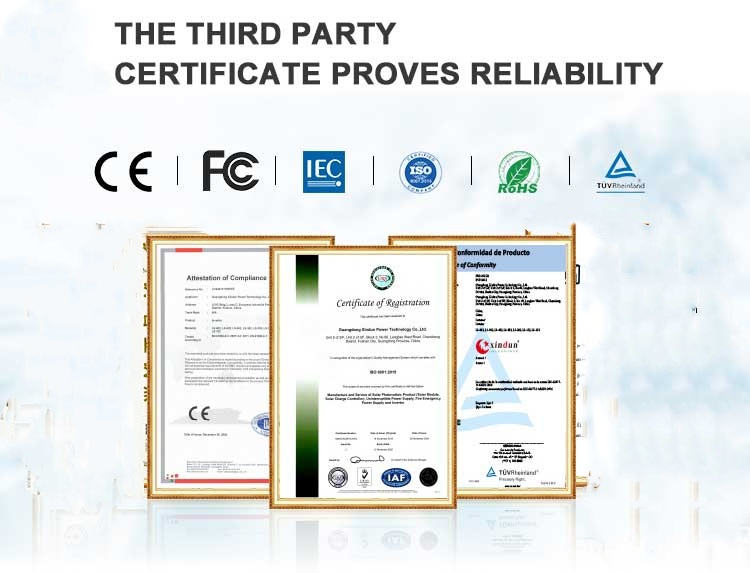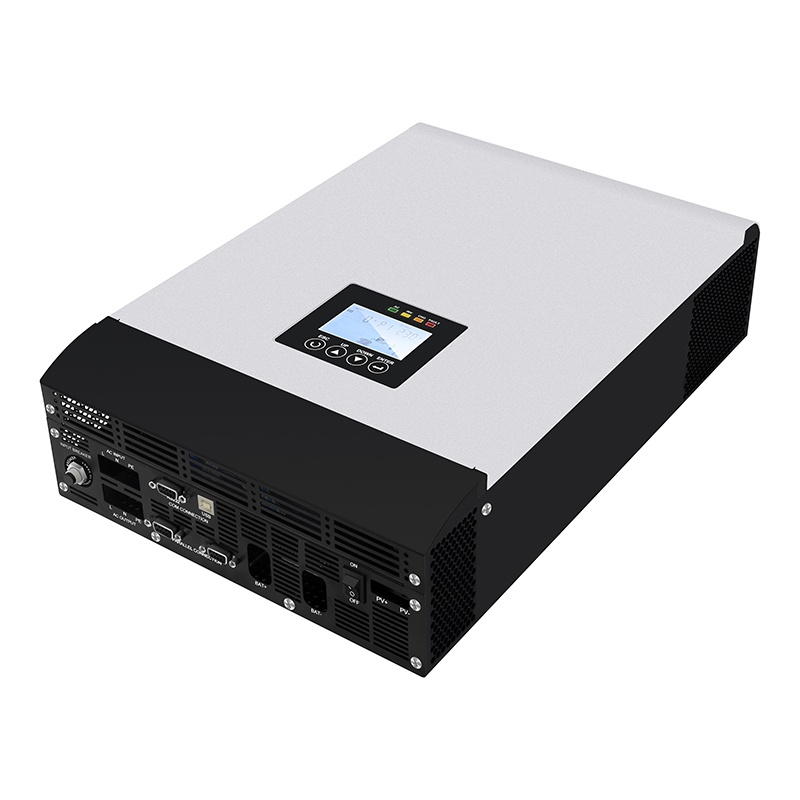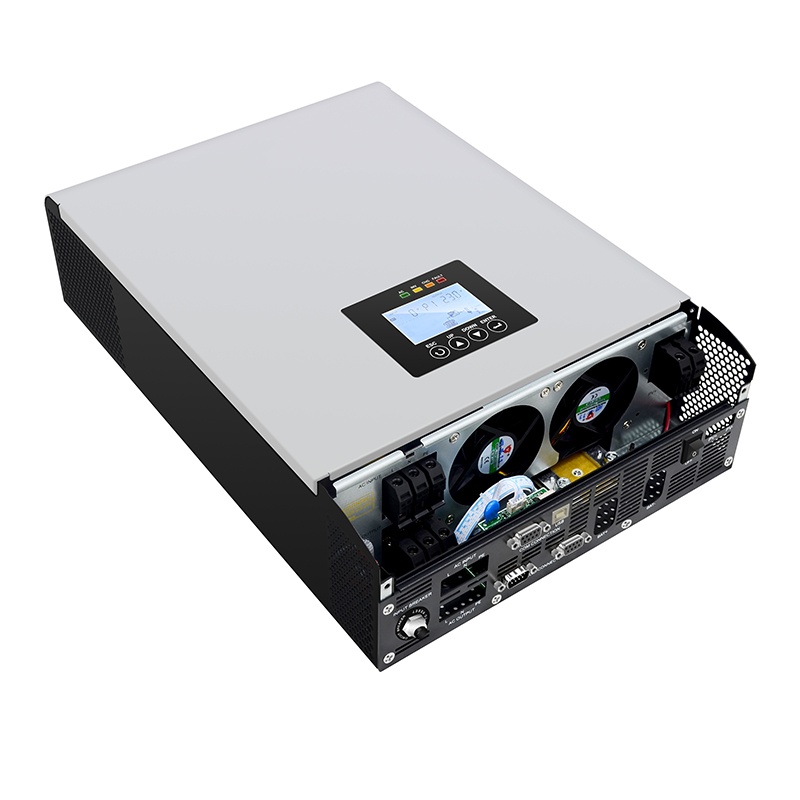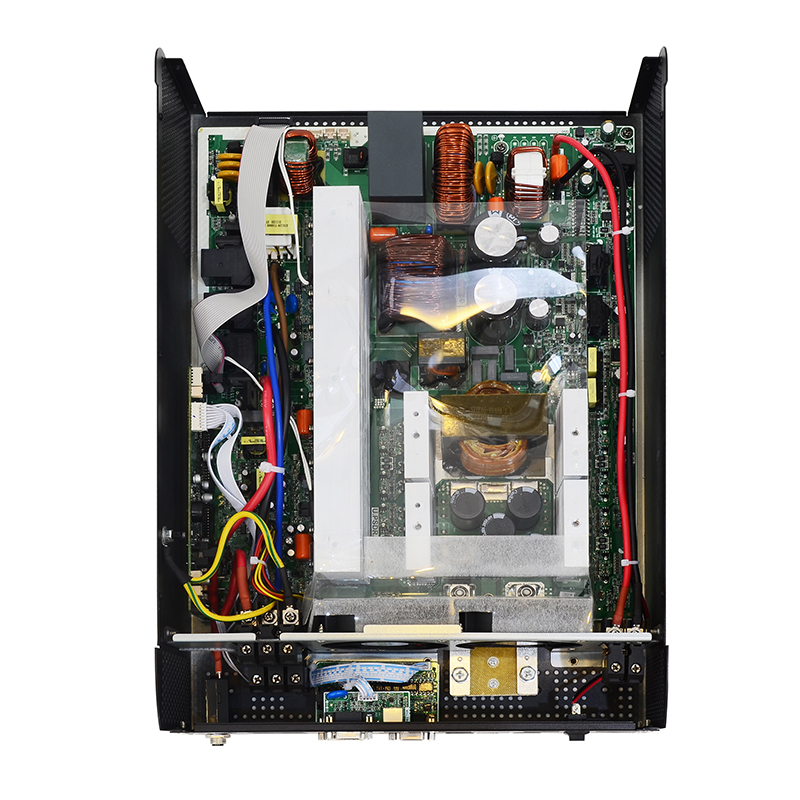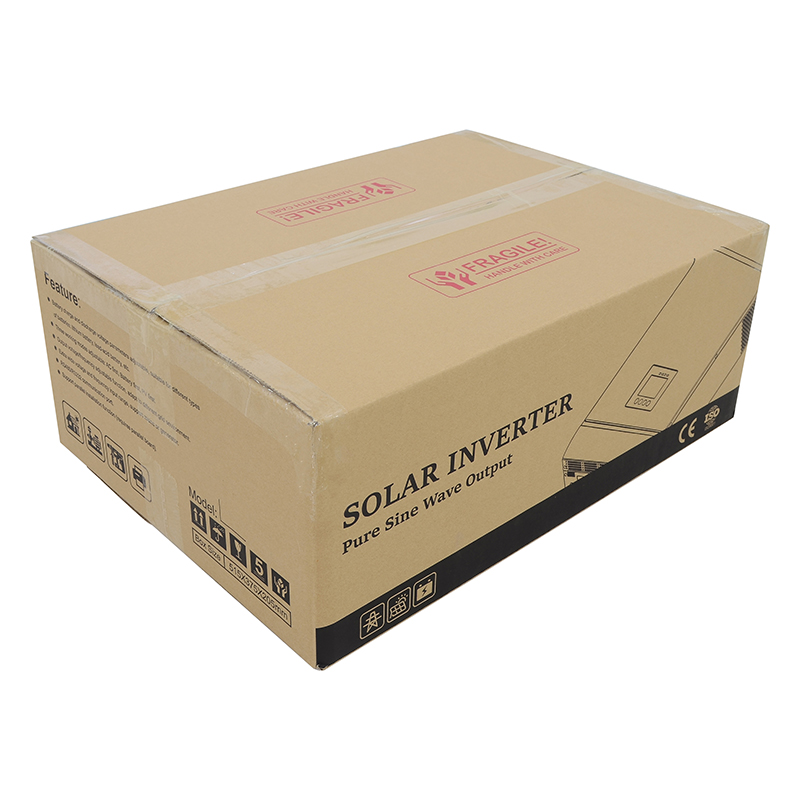
Single Phase Solar PV Photovoltaic Inverter Parallel
Solar PV Inverter Feature
1 Solar pv inverter parallel operation with up to 9 units.
2 Built-in MPPT solar controller ,solar input voltage up to 450V Maximum.
3 Combining solar energy, battery power source, AC power grid, generator to supply continuous power.
4 Support provide the power to the load without battery (Without inverter parallel operation).
5 Support USB, RS232 communication port, APP (WIFI/GPRS) optional.
6 High frequency pure sine wave design ,high efficiency with low no-load loss.
7 Perfect protection system: Battery low voltage, Battery over voltage, Overload power, Inverter output short circuit, Temperature protection
Solar PV Inverter Specification
The HP-Plus solar pv inverter with parallel function up to 9 units, So if you want 5kw, 10kw, 15kw, 20kw, 25kw, 30kw, 35kw, 40kw, 45kw single phase inverter, you can choose HP-Plus series.
| Specification | |||
| Model: | HP plus-502 | ||
| Rated Power | 5000W | ||
| Peak Power(20ms) | 15KVA | ||
| Battery Voltage | 48VDC | ||
| Product Size(L*W*Hmm) | 440x300x110 | ||
| Package Size(L*W*Hmm) | 515x375x205 | ||
| N.W(Kg) | 9.5 | ||
| G.W(Kg) | 10.5 | ||
| Installation Method | Wall-Mounted | ||
| PV | Charging Mode | MPPT | |
| Rated PV input voltage | 360VDC | ||
| MPPT tracking voltage range | 120V-430V | ||
| Max PV Input Voltage Voc | 450V | ||
| (At the lowest temperature) | |||
| PV Array Maximum Power | 5500W | ||
| MPPT tracking channels (input channels) | 1 | ||
| Input | DC Input Voltage Range | 42VDC-60VDC | |
| Rated AC input voltage | 208VAC/220VAC/230VAC/240VAC | ||
| AC Input Voltage Range | 90VAC~280VAC(Appliance mode)/170VAC~280VAC(UPS mode) | ||
| AC Input Frequency Range | 40Hz~70Hz(default) | ||
| Output | Output efficiency(Battery/PV Mode) | 94%(Peak value) | |
| Output Voltage(Battery/PV Mode) | 208VAC±2%/220VAC±2%/230VAC±2%/240VAC±2%(INV mode) | ||
| Output Frequency(Battery/PV Mode) | 50Hz/60Hz±0.1% | ||
| Output Wave(Battery/PV Mode) | Pure Sine Wave | ||
| Efficiency(AC Mode) | >99% | ||
| Output Voltage(AC Mode) | Follow input | ||
| Output Frequency(AC Mode) | Follow input | ||
| Output waveform distortion | ≤3%(Linear load) | ||
| Battery/PV Mode) | |||
| No load loss(Battery Mode) | ≤1% rated power | ||
| No load loss(AC Mode) | ≤0.5% rated power(charger does not work in AC mode) | ||
| Battery | Battery | VRLA Battery | Charge Voltage :56.4V; Float Voltage:54V |
| Type | Customize battery | Charging and discharging parameters of different types of batteries can be customized according to user requirements | |
| (charging and discharging parameters of different types of batteries can be set through the operation panel) | |||
| Max AC Charging Current | 60A | ||
| Max PV Charging Current | 80A | ||
| Maximum charging current (mains + PV) | 80A | ||
| Charging method | Three-stage (constant current, constant voltage, floating charge) | ||
| Working Mode | Mains priority/Solar priority/Battery priority(Can be set) | ||
| Transfer Time | ≤10ms | ||
| Communication(Optional) | RS232/USB/APP(WIFI monitoring or GPRS monitoring) | ||
| Environment | Operating temperature | -10℃~40℃ | |
| Storage temperature | -15℃~60℃ | ||
| Noise | ≤55dB | ||
| Elevation | 2000m(More than derating) | ||
| Humidity | 0%~95% (No condensation) | ||
Solar PV Inverter Details
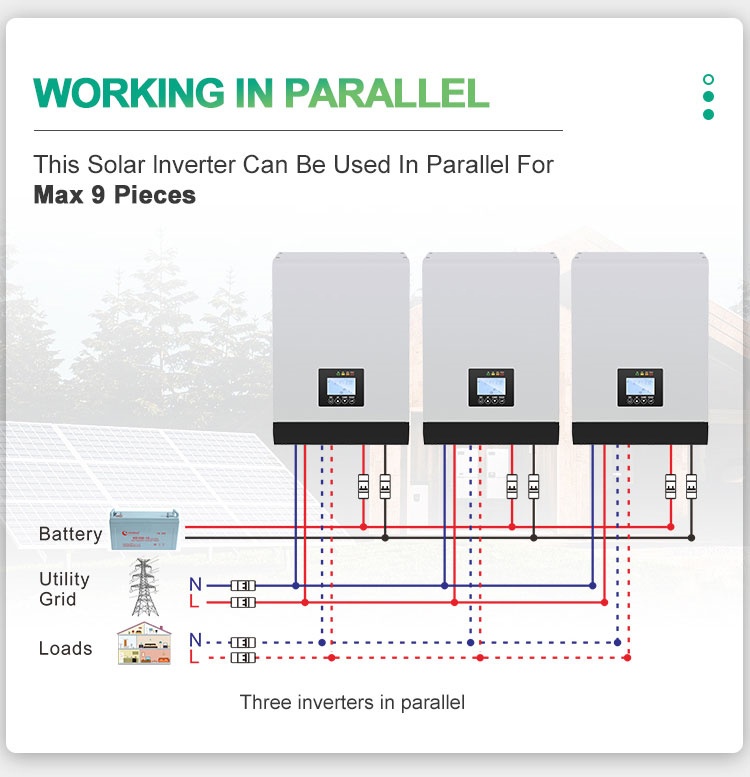






Solar PV Inverter Connection
We offer 3 optional working modes for solar pv inverter (transfer time≤4ms):
6.1:GRD Utility Grid Priority Output
Utility grid priority output, namely GRD mode, utility grid power supply priority:
a. Utility grid priority provide load energy; PV charge the battery.
b. When the photovoltaic energy is insufficient, the utility grid will charge the battery to make up the remaining charging current.
6.1.1 When the utility power is not connected
a. The photovoltaics give power to the load first, and the batteries are charged when the photovoltaics are sufficient.
b. When the photovoltaic energy is insufficient, the battery assists discharge.
c.When the battery auxiliary discharges to undervoltage, turn to stand by, and the photovoltaic charges the battery (charge the battery to 13V*N or manually turn the main switch to OFF and then to ON, the inverter output can be re-inverted)
6.1.2 When PV is not connected
a. Utility grid power supply priority, and charge the battery according to the current limit
b. When the utility grid power is lost, turn the battery to discharge, and when it discharges to a low voltage, turn to stand by
6.1.3 When the battery is not connected
a. Utility grid provides energy first
b. When the utility grid power is lost, the photovoltaic powers the load; when the photovoltaic energy is insufficient, the output protection is turned off (alarm 62, the alarm disappears after 10 minutes and the output is restarted)
6.2 PV Photovoltaic Priority Output
PV priority output, that is, PV mode, photovoltaic priority power supply:
a. The system switches to LINE mode, and the photovoltaic will feed back the utility grid power according to the load size (the photovoltaic excess energy is charged).
b. When the photovoltaic energy is insufficient, the load is given priority, and the battery charging current is reduced to 0. If the load is continued, the utility power will make up the remaining energy, and the inverter is still in LINE mode.
6.2.1 When the utility power is not connected
a. Give priority to photovoltaics to provide energy, and charge the battery when the photovoltaics are sufficient
b. When the photovoltaic energy is insufficient, the battery assists discharge.
c. When the battery is discharged to undervoltage, turn to stand by, and the photovoltaic will charge the battery (charge the battery to 13V*N or manually turn the main switch to OFF and then to ON, and the inverter can be output again).
6.2.2 When PV is not connected
a. Utility grid power supply, and charge the battery according to the current limit
b. When the utility grid power is lost, turn the battery to discharge, and when it is discharged to undervoltage, turn to stand by mode.
6.2.3 When the battery is not connected
a. The utility grid and PV are normal, the system switches to LINE mode, and the PV will feed power to the utility grid according to the size of the load, so that the utility grid input active power is close to 0.
b. When the utility grid power is lost, the system transfers to photovoltaic (battery mode) with load, and when the photovoltaic energy is insufficient, the output is turned off (alarm 62, the alarm disappears after 10 minutes and the output is restarted).
6.3:PBG (Battery) Priority Output
PBG output priority, photovoltaic>battery>utility grid output priority in order:
a. The system switches to battery mode, the PV is loaded first, and the excess energy is used to charge the battery.
b. When the PV energy is insufficient, the PV and the battery supply power at the same time.
c. When the battery is discharged to the set voltage (BTG), transfer to the commercial power supply. At the same time, the battery starts charging (charging according to the charging priority), and when the battery is charged above the set voltage point (BTB), it can be switched back to battery mode output.
6.3.1 When the utility power is not connected
a. Give priority to photovoltaics to provide energy, and charge the battery when the photovoltaics are sufficient
b. When the photovoltaic energy is insufficient, the battery assists discharge.
c. When the battery is discharged to undervoltage, turn to stand by, and the photovoltaic will charge the battery (charge the battery to 13V*N or manually turn the main switch to OFF and then to ON, and the inverter can be output again).
6.3.2 When PV is not connected
a. Prioritize battery discharge.
b. When the battery is discharged to the set voltage (BTG), transfer to the commercial power supply. At the same time, the battery starts charging, the battery is charged above the set voltage point (BTB), and it can be switched back to battery mode output.
c. When the utility grid power is lost, turn the battery to discharge,and when it is discharged to undervoltage, turn to stand by.
6.3.3 When the battery is not connected
a. The utility grid and PV are normal, the system switches to LINE mode, and the PV will feed the utility grid according to the load.
b. When the utility grid power is lost, the system transfers to photovoltaic (battery mode) with load, and when the photovoltaic energy is insufficient, the output is turned off. (Alarm 62, after 10 minutes, the alarm disappears and the output is restarted).
Solar PV Inverter Package and Delivery

Why Choose Us?

